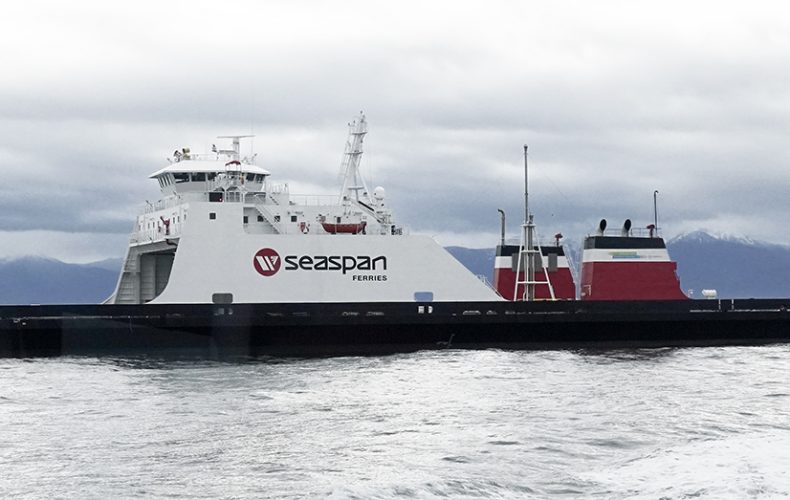Seaspan Ferries, Vancouver, British Columbia, recently took delivery of the first of two 6,750 dwt.,148.9mx26m (488'x85') LNG-battery hybrid cargo ferry Seaspan Swift. The company operates cargo-only services between Vancouver Island and the British Columbian mainland, carrying up to 800 trailers a day. Seaspan delivers more than 50% of all products consumed on the island, according to the company. A sistership, Seaspan Reliant, is scheduled to be delivered in the next 12 months.
Designed by Vard Marine and sporting a draft of 7m (23'), the steel monohull Seaspan Swift is the first LNG-battery hybrid cargo ferry in North America, according to Seaspan officials. The vessel features two dual-fuel engines and a Corvus lithium ion energy storage system (ESS), which operates as spinning reserve and provides propulsion power for low-speed maneuvers. Corvas provides high power energy storage in the form of modular lithium ion battery systems. Its purpose built, field proven battery systems are designed to provide sustained power to hybrid and fully electric heavy industrial equipment, including large marine propulsion drives. In this case, the engines connect to azimuthing drives that give the ferry a running speed of 16 knots.
Seaspan has plans to order three more of the 148m cargo ferries that have capacity for 59 truck trailers compared to the 30-40 trailer capacity of its existing seven vessels that have been in service for an average of 36 years.
“We are proud to be working with Seaspan, a fellow Canadian company and an innovator in its business operations,” Andrew Morden, president and CEO of Corvus, said in a statement announcing the delivery of the Seaspan Swift. “Seaspan’s commitment to environmental sustainability is industry-leading and Corvus looks forward to working with them to integrate Corvus Energy ESS solutions into their future vessels.”
The heart and soul of the new ferries are their main propulsion systems that consist of twin 9L34DF LNG-diesel dual fuel engines by Wärtsilä coupled to constant-speed generators with Wärtsilä LNGPac fuel systems. The combination produces 9,000 kW at 750 rpm of power installed with Dual Fuel (DF) engines that utilize diesel as the primary source of ignition and gas as a second fuel source for combustion. The DF engines can run either on diesel only, or through a combination of diesel and natural gas.
Seaspan officials said that LNG will reduce costs over the lifespan of the vessels, helping offset capital and increased costs of building new boats. Seaspan Ferries has been working closely with FortisBC for the past two years to secure its supply of LNG.
“Integrating the proven Corvus ESS technology into our new LNG-battery vessels will help us achieve our goal of minimizing the environmental impact of our operations, while reducing fuel consumption and operating costs,” Jonathan Witworth, Seaspan’s CEO, said in a statement. “Corvus’ experience, industry leadership and safety record made it an easy decision to utilize their battery systems.”Sedef Shipbuilding Inc., Tuzia/Istanbul, Turkey, built the Seaspan Swift, which has been classified by Bureau Veritas.





